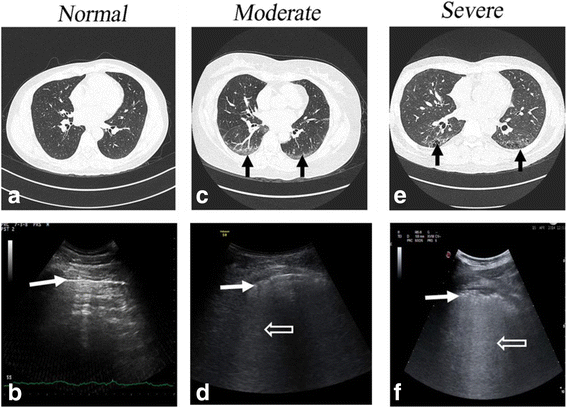Usefulness of lung ultrasound B-lines in connective tissue disease-associated interstitial lung disease: a literature review
- PMID: 28923086
- PMCID: PMC5604136
- DOI: 10.1186/s13075-017-1409-7
Usefulness of lung ultrasound B-lines in connective tissue disease-associated interstitial lung disease: a literature review
Abstract
Interstitial lung disease (ILD) is a major pulmonary manifestation of connective tissue disease (CTD), leading to significant morbidity and mortality. Chest high-resolution computed tomography (HRCT) is presently considered the diagnostic gold standard for pulmonary fibrosis diagnosis and quantification in the clinical arena. However, not negligible doses of ionizing radiation limit the use of HRCT, especially for serial follow-up in younger female patients. In the past decade, lung ultrasound (LUS) has been proposed to assess ILD by detecting and quantifying sonographic B-lines. Previous studies demonstrate that B-lines have a good diagnostic accuracy, especially high sensitivity, and correlate well with HRCT findings, suggesting LUS as a novel, non-invasive, and non-ionizing imaging method to be used in patients with CTD-ILD. Although preliminary data are promising, challenges and controversies still remain. For example, the mechanisms of B-line generation are not fully understood; the diagnostic accuracy and performance characteristics of LUS partially depend on the scanning scheme and scoring system used; and up-to-date B-lines cannot discriminate the early cellular inflammation from the chronic fibrotic phase in CTD-ILD. Therefore it is important for clinicians to understand the strengths and limitations of LUS in CTD-ILD patients, to maximize its value.
Keywords: Anti-synthetase syndrome; B-lines; Connective tissue diseases; High-resolution computed tomography; Interstitial lung disease; Lung ultrasound; Pleural irregularity; Rheumatoid arthritis; Sjögren’s syndrome; Systemic sclerosis.
Conflict of interest statement
Ethic
Not applicable.
Consent for publication
Not applicable.
Competing interests
LG received speaker honoraria from GE Healthcare and Glaxo-Smith-Kline. The remaining authors declare that they have no competing interests.
Publisher’s Note
Springer Nature remains neutral with regard to jurisdictional claims in published maps and institutional affiliations.
Figures

References
Publication types
MeSH terms
LinkOut - more resources
Full Text Sources
Other Literature Sources
Medical
Miscellaneous

